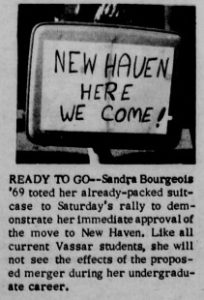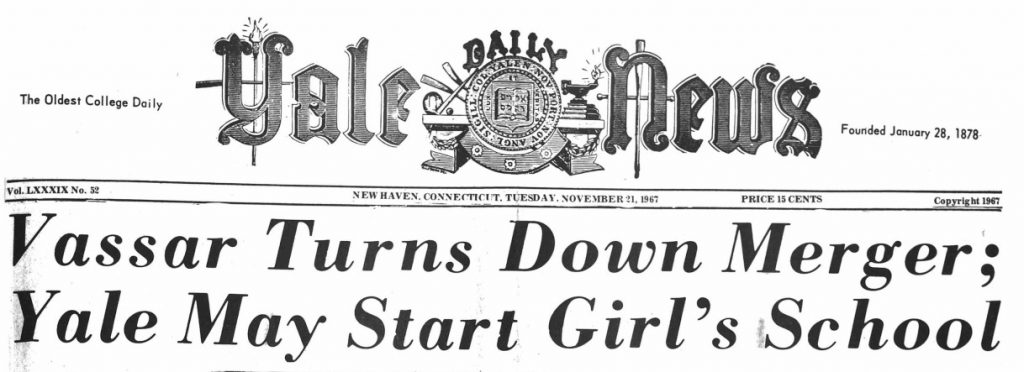By Emma Wiley
Today, students of all genders seem ubiquitous at Yale University. While Yale’s undergraduate school did not actually enroll women until 1969, few may know that it was a failed merger with Vassar College (a women’s college in Poughkeepsie, New York) that helped give Yale the final push into coeducation.
The Path to Coeducation
Yale and Vassar both started as single-sex colleges. During the mid-20th century, however, single-sex education there became less popular for numerous reasons. Many students at both schools desired co-ed social and academic opportunities—inside and outside the classroom. Vassar women often abandoned their rural campus on the weekends in favor of dates, dances, and other social events in New Haven or at other campuses. Alternately, unofficial events such as the Yale-Vassar Bike Race pulled Yalies west—the men leaving New Haven at sunrise and biking the 80+ miles to Poughkeepsie before sunset. In addition, to encourage socialization and relationships between the institutions, Yale and Vassar’s residential halls formed partnerships.
Both Yale and Vassar dabbled in coeducation for years. In 1869, Yale’s School of Art opened its doors to female graduate students and other graduate and professional schools followed suit throughout the century. After WWII, male veterans took classes at Vassar under the G.I. Bill but received diplomas from the State University of New York. Neither school, however, was truly and equally coeducational. When they started considering the possibilities of coeducation, the schools did not have to look far for a clear association—in fact, many described Yale and Vassar’s relationship as a “marriage.”
The Vassar-Yale Study

A current Vassar student already packed, ready to go to New Haven, Miscellany News, December 19, 1966 – Vassar College Library
In late 1966, Yale President Kingman Brewster Jr. and Vassar President Alan Simpson started seriously discussing a merger between the two schools. On December 14, 1966, Vassar’s Board of Trustees accepted the formal invitation from Yale to study the desirability and feasibility of moving to New Haven.
Before either president could announce the study, however, someone leaked the news to the New York Times. While many of Yale’s students were already on winter break, the news created quite the stir on Vassar’s campus. Those in favor of the merger abandoned their final exam studies and rallied in front of Main Building—singing Yale’s Whiffenpoof song and crying “Boola, Boola.” In honor of the announcement, Vassar’s school paper, the Miscellany News, published a special edition with dreams of the possibilities of what merging Vassar and Yale might mean—including suggestions for new terms such as “Vale” or “Yasser” girls.
For almost a year, the Vassar-Yale Study heard from students, faculty, administrators, and alumni from both schools. To fund the study, the Carnegie and Ford Foundations provided hundreds of thousands of dollars in grants with the proposed relocation site for Vassar in New Haven being the former campus of the Culinary Institute of America on Prospect Street. Administrators and faculty met to share data and information about how the schools and individual departments functioned—from graduation requirements to tuition costs to tenure policies and more.
While students from both schools were largely in favor of the merger, many Vassar alumnae remained incredibly unhappy and vocal about the proposal. Fearing the loss of their historic campus and deterioration of school identity, many wrote op-eds and letters to President Simpson, urging against the merger. To satisfy opposition, Simpson allocated $25,000 to Vassar’s Committee on New Dimensions to study alternatives to Vassar’s relocation.
Initially, many faculty and administrators at both schools seemed open to considering the merger and new opportunities. As more conversations occurred, however, the successful merging of institutions with different ideologies, policies, and courses of study grew increasingly difficult to imagine.
Coeducation at Last…But Not What You Think
After all the studies, conversations, meetings, and arguments, a Yale-Vassar merger was not meant to be. On November 20, 1967—almost a year after announcing the intention of studying coeducation between the two schools—the Vassar Board of Trustees ultimately voted not to merge with Yale.
Students from both schools reacted to the news in a variety of ways—dismay, anger, relief, and indignation. Both the Yale Daily News and the Miscellany News published a myriad of op-eds about the failed merger and the path forward for coeducation. Many of Yale’s articles took the angle of a rejected beau, one claiming that “Yale’s gentlemen suitors have been jilted.”
In the immediate aftermath of the failed merger, both Yale and Vassar announced the tentative creation of coordinate colleges offering a connected, yet separate, space for men and women. Those plans never materialized and within two years both Yale University and Vassar College went fully coed . . . separately.
Emma Wiley is the Digital Humanities Assistant at CT Humanities and holds a B.A. in History from Vassar College.










